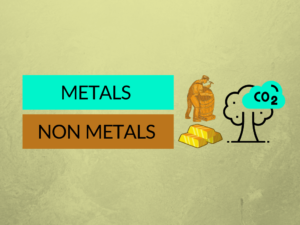What is/are lanthanoids?
Lanthanoids, also known as lanthanides, are a group of 15 metallic chemical elements with atomic numbers ranging from 57 to 71. They belong to the f-block of the periodic table and are commonly placed below the main body of the table. Lanthanoids are often referred to as rare-earth elements due to their occurrence in low abundance in the Earth’s crust.
Examples of lanthanoids:
The lanthanoid series includes elements such as:
- Lanthanum (La)
- Cerium (Ce)
- Praseodymium (Pr)
- Neodymium (Nd)
- Promethium (Pm)
- Samarium (Sm)
- Europium (Eu)
- Gadolinium (Gd)
- Terbium (Tb)
- Dysprosium (Dy)
- Holmium (Ho)
- Erbium (Er)
- Thulium (Tm)
- Ytterbium (Yb)
- Lutetium (Lu)
Uses of lanthanoids:
Lanthanoids find applications in various fields due to their unique properties. Some common uses of lanthanoids include:
- Catalysts in petroleum refining
- Components in energy-efficient lighting
- Phosphors for color display devices
- Permanent magnets
- Ceramic capacitors in electronics
- Additives in glass production
- Fluid cracking catalysts in petroleum refining
- Alloying agents to improve the strength of metals
- Scintillators for medical imaging
- Enhancement of fuel cells
What is/are actinoids?
Actinoids, also known as actinides, are a series of 15 metallic chemical elements with atomic numbers ranging from 89 to 103. Similar to the lanthanoids, actinoids also belong to the f-block of the periodic table. However, actinoids are commonly placed below the lanthanoids due to their atomic numbers.
Examples of actinoids:
The actinoid series includes elements such as:
- Actinium (Ac)
- Thorium (Th)
- Protactinium (Pa)
- Uranium (U)
- Neptunium (Np)
- Plutonium (Pu)
- Americium (Am)
- Curium (Cm)
- Berkelium (Bk)
- Californium (Cf)
- Einsteinium (Es)
- Fermium (Fm)
- Mendelevium (Md)
- Nobelium (No)
- Lawrencium (Lr)
Uses of actinoids:
The actinoids have both practical and scientific uses. Some common applications of actinoid elements include:
- Nuclear fuel for power generation
- Production of radioactive isotopes for medical purposes
- Research in nuclear physics and chemistry
- Development of radiation detection devices
- Use in nuclear weapons
- Investigation of chemical bonding and reactivity
- Neutron sources for scientific research
- Production of heavy isotopes for scientific studies
- Control rods in nuclear reactors
- Target materials for particle accelerators
Differences Table:
| Difference Area | Lanthanoids | Actinoids |
|---|---|---|
| Position in Periodic Table | Belongs to the f-block, placed between groups 2 and 3 | Also belongs to the f-block but placed below the lanthanoids |
| Atomic Numbers | Atomic numbers range from 57 to 71 | Atomic numbers range from 89 to 103 |
| Stability of Isotopes | Most isotopes are stable | Many isotopes are radioactive and highly unstable |
| Radioactivity | Some lanthanoids exhibit weak radioactivity | Actinoids are highly radioactive |
| Abundance | Lanthanoids are relatively abundant in the Earth’s crust | Actinoids are relatively rare in the Earth’s crust |
| Utilization | Lanthanoids find applications in various industries | Actinoids have more specialized applications, mostly related to nuclear technology |
| Electron Configurations | Lanthanoids have the 4f electron configuration | Actinoids have the 5f electron configuration |
| Occurrence in Nature | Soluble compounds of lanthanoids occur naturally | Actinoids occur naturally in various ores |
| Mass | Larger in atomic mass compared to actinoids | Smaller in atomic mass compared to lanthanoids |
| Radioactive Decay | Lanthanoids exhibit stable radioactive decay | Actinoids show different types of radioactive decay |
Conclusion:
In summary, lanthanoids and actinoids are two distinct series of elements with unique properties and applications. Lanthanoids, which include elements with atomic numbers from 57 to 71, are relatively abundant and find uses in various industries. On the other hand, actinoids, with atomic numbers from 89 to 103, are highly radioactive and have specialized applications mainly in nuclear technology. The differences in their position in the periodic table, atomic numbers, stability, radioactivity, abundance, electron configurations, and uses make them significant in the world of chemistry and industry.
People Also Ask:
Q: What are the similarities between lanthanoids and actinoids?
A: Both lanthanoids and actinoids belong to the f-block of the periodic table. They exhibit similar properties such as high melting points, strong paramagnetism, and the ability to form colored compounds.
Q: Can lanthanoids and actinoids be found in their pure form in nature?
A: Generally, lanthanoids and actinoids are not found in their pure form in nature. They occur as mixtures with other elements and compounds, requiring extraction and purification processes for isolation.
Q: What are some common applications of lanthanoids and actinoids in medicine?
A: Lanthanoids find use in medical imaging systems as contrast agents and scintillators for radiation detection. Actinoids, particularly uranium and plutonium isotopes, have roles in radiation therapy for cancer treatment.
Q: How are lanthanoids and actinoids different from transition metals?
A: Lanthanoids and actinoids differ from transition metals in terms of their electron configurations, size, and magnetism. Lanthanoids and actinoids have incompletely filled f-orbitals, while transition metals have incompletely filled d-orbitals.
Q: Are lanthanoids and actinoids chemically reactive?
A: Lanthanoids are relatively reactive, but actinoids exhibit more chemical reactivity due to their higher atomic numbers and the presence of additional f-electrons.


